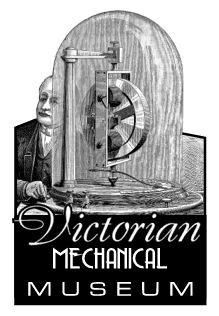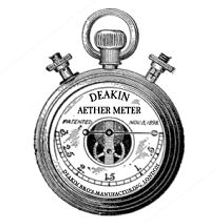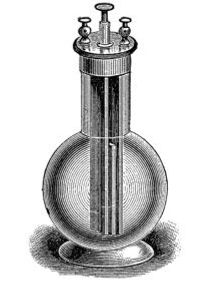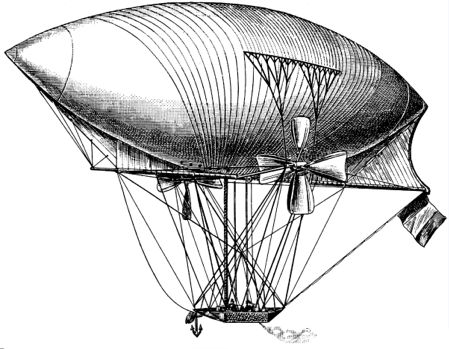The retired newspaper reporter in question is Adler Fanshaw, whose association with the Society of the Mechanical Sun and the Hawkins Strongbox histories spans parts of both the 19th and 20th centuries. Fanshaw gained admission to the secret organization in late 1882, shortly after he assisted Timothy Deakin rescue Deakin's younger brother Jack from criminal underlings working for Dr. Enoch Cyncad. Fanshaw moved to America in 1921 and in his retirement wrote pulp fiction for various publications. As noted in a recent exhibit here, his Rocket City series of stories was adapted into three successful movie serials in the early 1940s. With the Strongbox discovery of Tomorrow Comics #1, it is revealed that Fanshaw was also writing scripts for comic books as well.
Archer Bowens, Documents Archivist for the Victorian Mechanical Museum, was instrumental in discovering and deciphering the contents of the Fanshaw Envelope (Collection Item 111) which revealed evidence of Fanshaw's superficially disguised, Mechanical Sun inspired storytelling. Bowens notes, "We were aware of Adler's short fiction, most notably what was published in Starling Stories. But it never came to our attention that he was doing comic book work as well." He adds, "Even though the comic book credits never include his first name, the Sparky Elektro story in Tomorrow Comics #1 leaves no doubt that the comic book Fanshaw and Alder Fanshaw are one in the same."
Tomorrow Comics was published by Lake City Periodicals, a small magazine company based in Chicago. Issue #1 featured the debut of Sparky Elektro, a superhero who could "harness the raw power of electricity itself." The untitled story is credited to Fanshaw and Brooks and is highly derivative of names and places relating to the 1939 New York World's Fair. The name Sparky Elektro is a direct lift from Elektro the robot, the premiere attraction at the fair's Westinghouse pavilion. The story itself takes place at the fair and the fictional Robot Exhibition Building is based on the design of the actual Westinghouse pavilion.
Fanshaw's indirect but obvious allusions to the Society of the Mechanical Sun are reflected in the characters of "evil scientist Dr. Sin-Cad" and "scientist and businessman Bernard Zeevander," derived from real life counterparts Enoch Cyncad and Berkley Vanderzee. The story focuses on Sin-Cad's attempt to steal Zeevander's World's Fair robots and then unlock the secret of the mysterious energy source that powers them. It is a reference to Berkley Vanderzee's æther-powered intelligent automata and Enoch Cyncad's numerous attempts to appropriate them.
"Adler struggled with an obvious paradox for most of his life," observes Bowens. "How does one reconcile being a dedicated journalist, always striving for truth and transparency, and at the same time commit to the secrecy of a covert society of scientists whose discoveries and inventions were newsworthy beyond measure? Later in his life he could contain it no longer and it emerged in the form of pulp fiction and comic book adventures."
Fanshaw likely considered these fictionalizations benign and harmless, but the material most definitely alarmed other Society members, as indicated by the typewritten letter found tucked inside the comic book:
Geoffrey,
Please pardon the impersonal nature of the typewritten missive but my arthritis has been paining me beyond measure these last few weeks.
Why am I forwarding to you a child's comic? I can only relate to you my shock when little George was reading aloud from its stories. I hear him cite the names Sin Cad and Zeevander. Upon examining the comic more closely, it appears that the story is a veiled reference to events we have strived to obscure for the past half century. We have long been worried about Adler's sometimes dangerous eccentricities, and this most certainly validates those concerns. He did not even bother to conceal his own name in the publication.
We have warned him repeatedly in recent years about tangible threats. We know that the Germans are actively searching for Society secrets and this has the potential to compromise the safety of our family and friends. But he continues to ignore all attempts at contact or correspondence. A personal visit, perhaps?
Share with me your thoughts,
T.
The tangible threats that Deakin references eventually caught up to Fanshaw shortly before his death in 1953, as documented by the aforementioned Collection Item 111: The Adler Fanshaw Envelope. Whether Cameron Starkweather specifically followed these same comic book breadcrumbs to Fanshaw is as yet to be determined.






















0 Observations:
Post a Comment